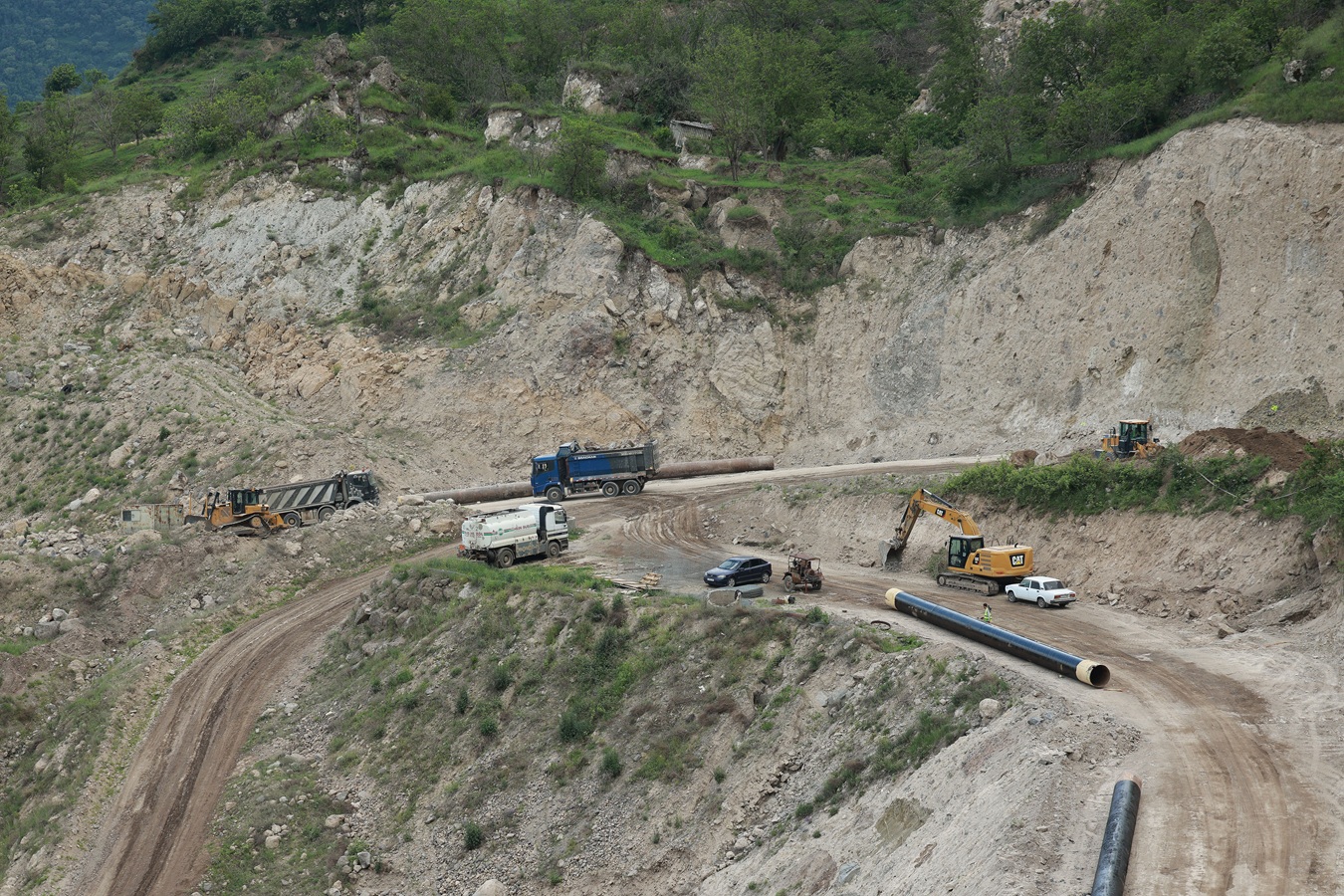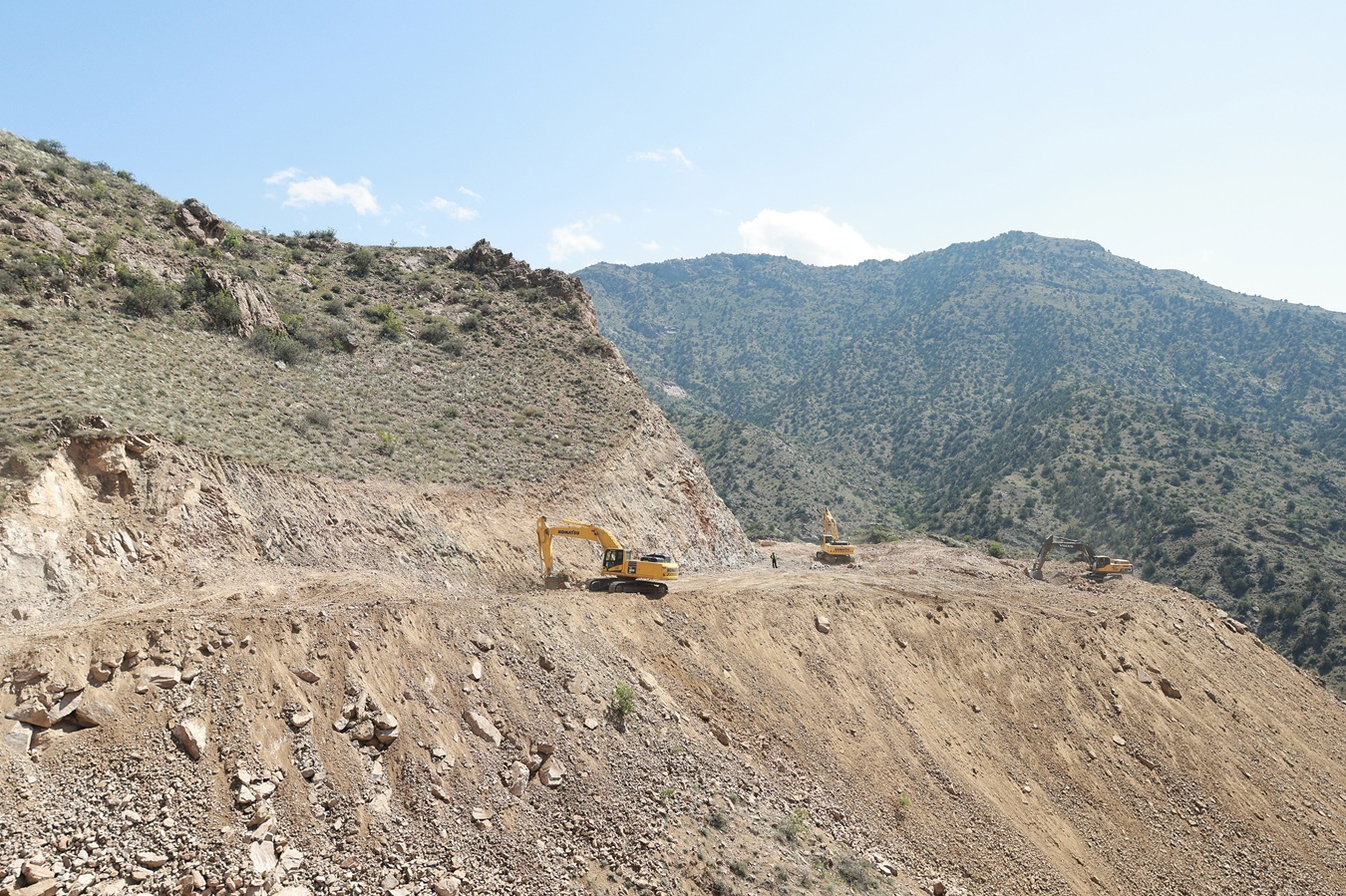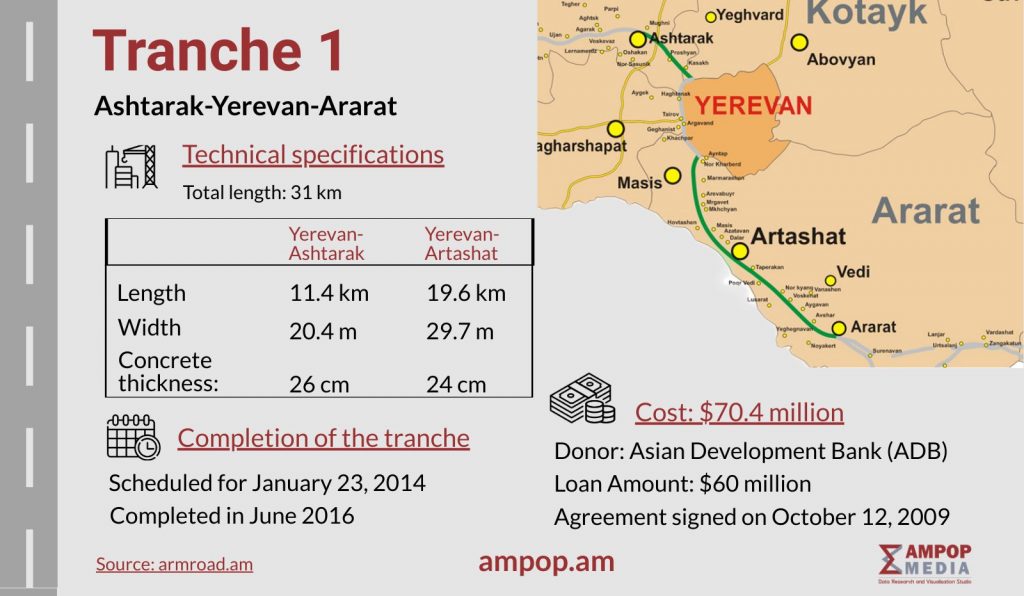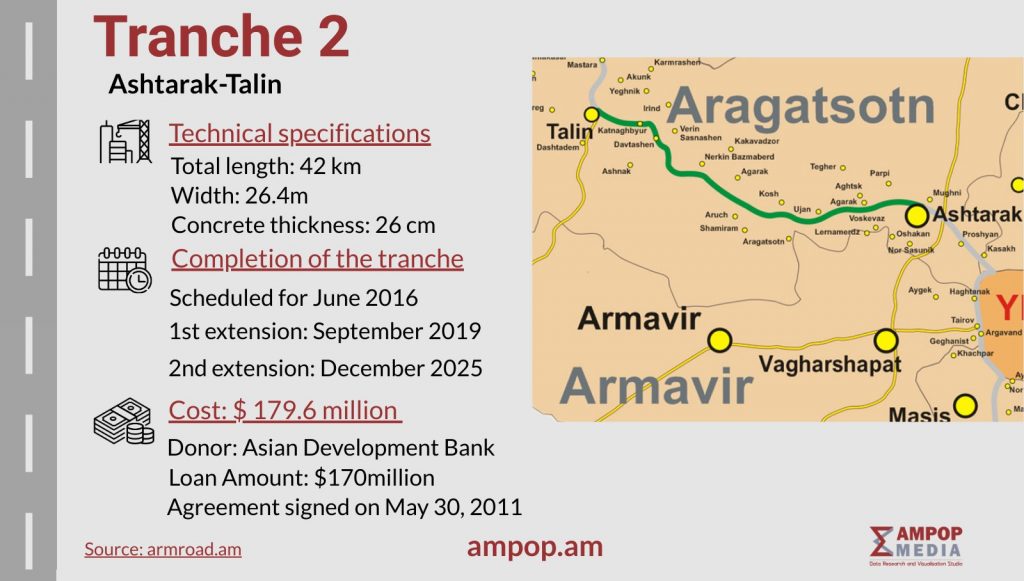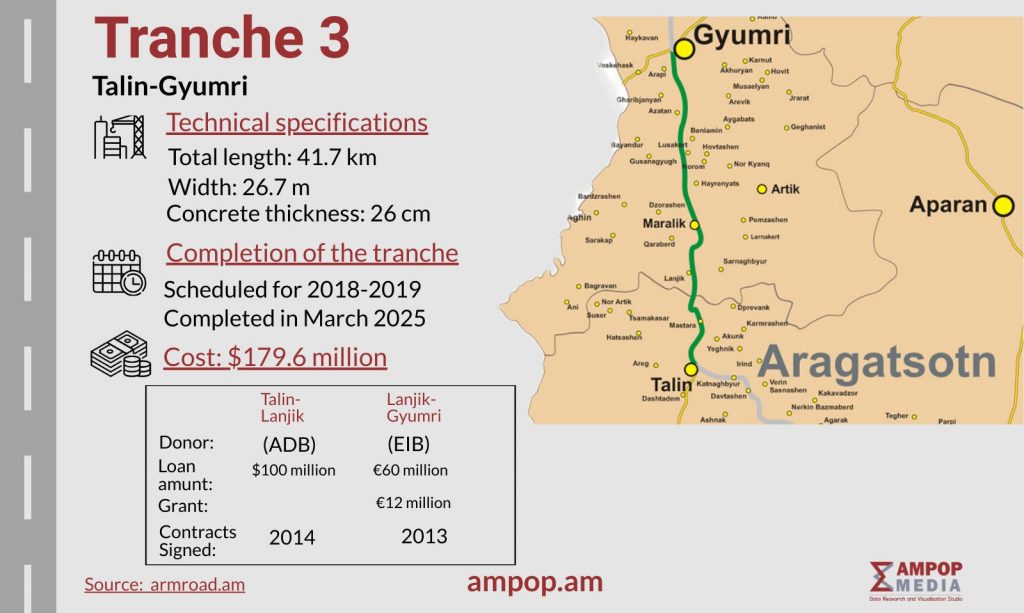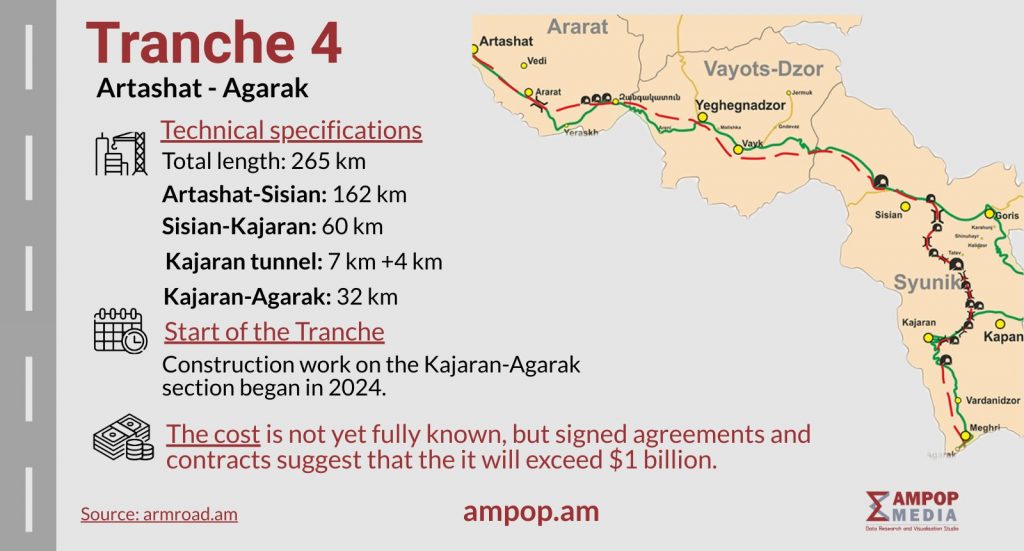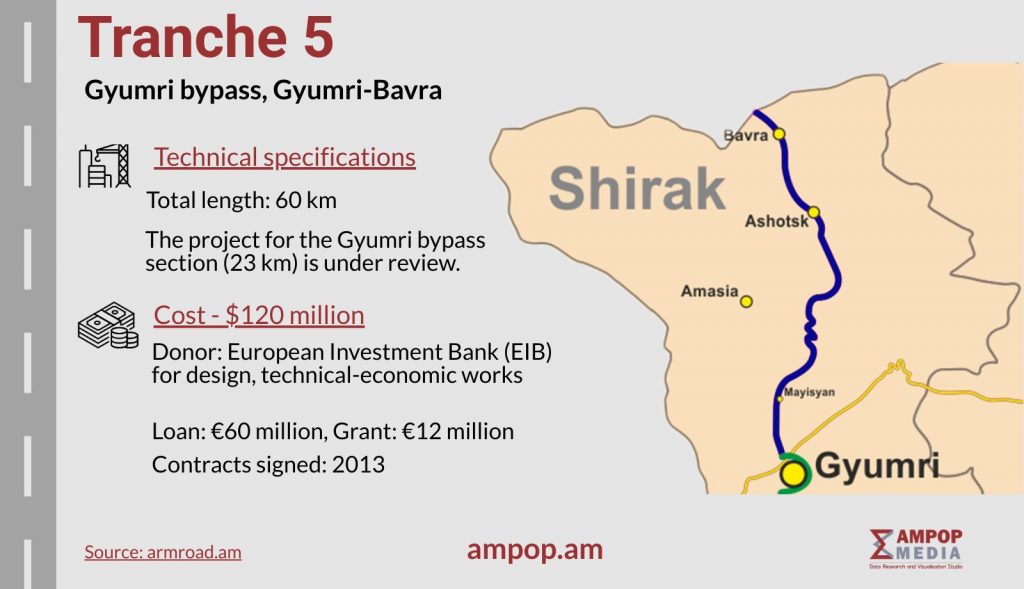The North–South Road Corridor Investment Program is being implemented through a multi-tranche financing structure. It is divided into five separate tranches, for which the Armenian government has signed loan agreements or contracts with international banks.
To date, the largest share of funding — $304.6 million USD — has come from the Asian Development Bank (ADB), covering construction works across three tranches. The European Investment Bank (EIB) has allocated USD 60 million for the construction works of Tranche 3, and an equal amount for the design phase of Tranche 5. The Eurasian Development Bank(EDB) has contributed USD 150 million for Tranche 4. In addition to funding from international financial institutions, the Government of Armenia is also co-financing the project from its own budget. (We have sent the question—how much funding has been provided from Armenia’s own budget—to the Ministry of Territorial Administration and Infrastructure. As soon as we receive their response, we will publish it in the article.)
The procurement and oversight of the Program are managed by the Road Department Fund, which operates under the RA Ministry of Territorial Administration and Infrastructure.
Ampop Media reviewed procurement records related to the North–South Road Corridor Investment Program for the years 2019–2025, using data from gnumner.minfin.am and armroad.am. We were able to locate only brief summaries of about 21 contracts awarded during this time. However, the full texts of these contracts are not published on any official platform.
In response to an inquiry from Ampop Media, the Ministry stated that: “International tenders are carried out in accordance with the procurement guidelines and procedures of the funding international organizations. The template documents and contracts used in these tenders are prescribed by the guidelines and are considered confidential.”
Notably, contracts signed through Armenia’s domestic procurement process are also not published online. The Ministry explained that these procurements are conducted in paper format, which is why they are not available on the armeps.am e-procurement system.

Procurement expert Artak Kyurumyan expressed concern about the lack of transparency for the public. “Even if the procedures follow the rules of international funding institutions, that doesn’t absolve the contracting state bodies from being accountable to the Armenian public. I have never seen an international partner say that public transparency should be ignored. Armenian agencies managing major projects funded by international partners must remain accountable to society. Otherwise, public resources are being used without public oversight.”
Another key question raised is: What confidential information could a road construction contract actually contain?
Under international procurement procedures, the largest contracts typically involve civil works, preliminary designs, engineering services, and technical oversight. These are often conducted through open international tenders, least-cost selection, single-source procurement, or individual consultant selection.
In contrast, contracts procured under Armenia’s national procedures typically involve smaller budgets — such as financial audits, environmental and social impact assessments, or land acquisition consulting services.
Kyurumyan explained that international lenders usually require the use of their own procurement systems because they do not trust Armenia’s public procurement system.
“Yes, partner institutions generally demand that their procedures be followed. Why? Because they don’t trust Armenia’s procurement mechanisms. There have been assessments where they found our system doesn’t meet their standards, and so they insisted on using their own procurement frameworks.”

In an interview with Ampop Media, the Deputy Minister of Territorial Administration and Infrastructure Kristine Ghalechyan explained the oversight role that donors play in the process:
“Every phase of the tender process must receive formal approval from the donor organization, in line with procurement guidelines. Prior to this approval, the donors may raise multiple monitoring-related questions to clarify various procurement decisions.”
She added that donor institutions monitor the entire procurement process, and regardless of whether a contract has been signed or a tender completed, they can initiate audits or additional reviews at any time to verify the documentation.
Of the 21 contracts Ampop Media reviewed, 8 were granted using Armenia’s price quotation method. According to Armenia’s Law on Procurement, competitive tendering is the preferred method, and alternatives like price quotations or single-source procurement require proper justification.
“There’s a clear problem when a contract is granted directly through price quotation. The law prioritizes open tendering, and if that’s not used, authorities must provide serious and well-grounded justifications,” said Kyurumyan.
The value of the largest contract signed through the price quotation method is 22.9 million AMD. It was concluded in 2023 between the Road Department Fund and “Alta Vip” LLC for the construction of access roads on the Lanjik–Gyumri section of Tranche 3, specifically for the preparation of supplementary services related to the land acquisition and resettlement program.
Ampop Media has also submitted an inquiry to the Ministry of Territorial Administration and Infrastructure to clarify why procurement was conducted through a quotation-based method, and on what grounds the contracts signed in accordance with the procurement procedures of international financial institutions are not publicly accessible. (Once an official response is received, we will update this section accordingly.)
Overall, the total value of all contracts granted via price quotation exceeds 1 million AMD — the legal threshold above which competitive methods are typically required. If a purchase falls below that threshold, non-tender procedures may be used, such as direct acquisition — but this usually requires either that the service is not listed on the e-auction platform or that another formal justification exists.
In general, procurement may be conducted through the quotation method if the total cost does not exceed 70 million AMD and the item to be procured is not included in the list of services subject to electronic auction. In cases involving state secrecy, the item must be included in the list of services to be acquired through a closed periodic competition.
Major Procurements in the North–South Investment Program by Tranches
Tranche 1
The North–South Road Corridor Investment Program was officially launched in 2009, when the first loan agreement for Tranche 1 was signed.
Tranche 1 includes the Yerevan–Ashtarak (11.4 km) and Yerevan–Artashat (19.6 km) road sections — totaling 31 km in length. While the official construction was declared complete in 2016, large-scale construction works resumed on some sections of Tranche 1 in June, shortly after project close. These works were financed using savings from Tranche 3.
The design work for Tranche 1 was carried out by the French company Egis, which also served as the design and construction consultant for Tranche 2 (Ashtarak–Talin, 42 km). The main construction contractor for Tranche 1 was the Spanish company Corsan Corviam Construccion S.A.
The value of the Tranche 1 construction contract amounted to $70.4 million USD. Of this, $60 million USD came from the ADB loan, while around $15 million USD — specifically covering taxes — was financed by Armenia’s state budget.
Although the contract with Corsán Corviam Construcción remained in force until July 18, 2019, the company ceased work and left Armenia at the end of 2018. As mentioned in the first article in Ampop Media’s series on the North–South Corridor, the government terminated the contract with the company, and the legal dispute is still ongoing in international arbitration.
Since 2018, there has also been an ongoing criminal investigation into alleged abuses within Tranche 1 and Tranche 2 of the North–South Road Corridor Investment Program. The case remains in the pre-trial investigation phase.
Ampop Media also submitted a written inquiry to the Asian Development Bank (ADB), asking whether the loan provider had recorded any violations or unmet obligations during the implementation. The ADB responded in writing:
“This question appears to be of a general nature and may be relevant to specific cases, if any. For Tranche 1, compliance with loan covenants is thoroughly documented in the Project Completion Report, which outlines implementation results and the status of agreed obligations. No violations have been formally recorded to date in the finalized reporting.”
Tranche 2
In Tranche 2, a contract was signed with the French-German joint venture “Egis International” and “Kocks Consult” to address gaps identified in 2021. Under one part of the contract, they spent nine months calculating the volumes of unfinished work left by the previous contractor, revising the design, and preparing new tender documents.
The cost of this service was approximately $651,000 USD.
Under the second part of the contract, they acted as the Engineer for an 18-month period, for a fee of around $3.148 million USD. This international contract was signed via single-source procurement, meaning there was no competitive tender. Such procurements, especially involving large sums, require clear justification.
Construction works in Tranche 2 only resumed in 2023, with two active sections: An 8-kilometer detour bypassing the Agarak archaeological site, and a 34-kilometer section of the Yerevan–Gyumri–Bavra highway.
Construction in the first section has already been completed. The contract duration was 18 months, and the contractor was the joint Venture A.A.B. Project LLC (Armenia) – M/s Dineshchandra R Agrawal Infracon Pvt. Ltd (India).
The 34-kilometer section of the Yerevan–Gyumri–Bavra road is expected to be completed by the end of this year. Construction here is being carried out by the Joint Venture Levantina, Ingenieria y Construccion, S.L. & Obras Publicas y Regadios, S.A.
The contract value is $75.985 million USD. This procurement was conducted via the ADB’s international one-stage/two-envelope bidding process, where participants submitted both technical and financial proposals.
To support the implementation of Tranche 2, the Asian Development Bank provided $170 million USD in financing. Additional funds were also allocated from Armenia’s state budget.
Tranche 3
Construction works under Tranche 3 were carried out on two sections: Talin–Lanjik (18.7 km) and Lanjik–Gyumri (23 km).
For the Talin–Lanjik section, the Asian Development Bank (ADB) provided $100 million USD. The Armenian state budget allocated a total of $32.4 million USD, including approximately $20.5 million USD for taxes, around $8.5 million USD for land acquisition and resettlement (for the entire Talin–Gyumri section), and about $3.4 million USD for infrastructure relocation.
Construction works on the Talin–Lanjik section were completed in October 2022. The contractor was the Chinese company Sinohydro Corporation Ltd.
For the Lanjik–Gyumri section, the European Investment Bank (EIB) allocated €60 million, and the Neighborhood Investment Facility (NIF) Grant provided €12 million. The Armenian state budget contributed around €16.2 million in taxes. Construction in this section was completed in March 2025 and was carried out by the same company.
Since 2021, technical supervision for this section has been provided by the Italian consultancy IRD Engineering. The contract duration was set at 32 months, with a total value of $264,000 USD, €919,000, and 280 million AMD. The same company, in partnership with another, also supervised the Talin–Lanjik section.
Tranche 4
Tranche 4 consists of four subsections: Artashat–Sisian, Sisian–Kajaran, Kajaran Tunnel, and Kajaran–Agarak.
Currently, construction is underway on the 32 km Kajaran–Agarak road section. Before the actual construction began, based on a contract signed in 2019, the preparation of the land acquisition and resettlement plan for the Kajaran–Agarak section, the development of the contract design, and supervision of the 32 km road from Agarak to the tunnel exit were carried out by the Italian joint venture J/V IRD Engineering S.R.L. and GP Ingegneria S.R.L. The contract was valued at €1.943 million, with a duration of two years.
The construction work is being carried out by a joint venture of two Iranian companies: Abad Rahan Pars International Group and Tunnel Sadd Ariana. The contract was signed in 2023 for a duration of five years, with construction beginning in 2024. The contract’s total value is $214.388 million USD, making it the most expensive among the 21 contracts examined.
The procurement was conducted through an open international tender. The donor organization is the Eurasian Development Bank. Technical supervision consulting services for this section are provided by Institute IGH, Joint-Stock Company for Research and Development in Civil Engineering (Croatia). The contract was signed in 2023, with a 36-month duration and a total value of $1.704 million USD.
A tender for the construction of the Kajaran Tunnel was announced on April 23, 2024. The construction is planned to take six years, followed by a two-year warranty period for addressing potential deficiencies. A loan agreement was signed with the Eurasian Fund for Stabilization and Development, which will allocate $200 million USD for the construction of the Kajaran Tunnel and the reconstruction of an existing 4 km road section.
To implement construction in other subsections of Tranche 4, several contracts and agreements have been signed with international financial institutions.
Over the past year alone, the value of contracts for constructing the Sisian–Kajaran section has reached €708 million.
On May 15, 2024, an agreement was signed with the European Bank for Reconstruction and Development (EBRD) for €236 million to build the southern 24.2 km section of the Sisian–Kajaran road. On December 15 of the same year, another contract was signed with the European Investment Bank (EIB) for €236 million, as part of the program “Armenia: Sisian–Kajaran Road Section – European Fund for Sustainable Development + Special Investment Window 1.” In 2025, the government approved an additional ADB €236 million loan for the construction of a 27.1 km section of the North–South Road Corridor.
Tranche 5
Tranche 5 includes the Gyumri bypass road and Keti–Bavra road section, with a total length of 60 kilometers. Taking into account the prospect of constructing a “dry port” in the region, it was decided to make use of the Eastern Partnership Investment in Connectivity (EPIC) program toolkit. This cooperation has been officially endorsed.
Summary
More than a decade since its launch, the North-South Road Corridor remains one of Armenia’s most ambitious yet troubled infrastructure projects. While billions in international loans and state funds have been poured into its development, the project continues to be marred by construction delays, vague timelines, opacity in procurement processes, and doubts about its long-term economic returns.
For now, its future depends not only on continued financial support but also on a clear commitment to transparency, accountability, and efficient execution—conditions that, if unmet, risk turning this national megaproject into a symbol of missed opportunity.
Project team: Maria Khachatryan, Van Simon, Karine Darbinyan, Suren Deheryan
We thank our colleague Artak Khulyan for generously sharing his valuable expertise on the topic.
Photo and video source: Road Department Fund
Related articles
This article was made possible with the support of CIPE as part of the project ‘Responding to the Threat of Corrosive Capital in Armenia: Expanding the capabilities of Armenian media and civil society as watchdogs for illicit/corrosive financial flow and capital flow risks,’ funded by UK International Development from the UK government. The views and opinions expressed in any investigations or media products developed as part of this project are solely those of the authors and do not necessarily reflect the views of the Center for International Private Enterprise (CIPE) or the Foreign, Commonwealth & Development Office (FCDO)
© All the stories, infographics and other visuals bearing the Ampop Media logo is possible to publish on other audiovisual platforms only in case of an agreement reached with Ampop Media and/or JFF.
Փորձագետի կարծիք
First Published: 20/06/2025


